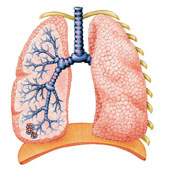


Understanding Your Breathing Test Results There are many ways that a doctor can tell if your lungs are working properly. First, the doctor can do a physical exam using a stethoscope. The doctor will listen to hear if any of the “breath sounds” are abnormal. For example, wheezing, a high-pitched sound produced by airflow through narrowed airways, is an example of an abnormal sound. The doctor can also take a picture of your lungs using a chest x-ray or CAT scan to look for abnormalities in the structure of the lungs, such as an infection like pneumonia. However, these two tests can still miss important problems. For this reason, a breathing test, called spirometry, is often done to further evaluate the health of the lungs. Spirometry can tell you how much air is going into
the lungs and how rapidly air is inhaled and exhaled in the lungs
(airflow). Spirometry is performed by deeply inhaling and forcefully exhaling into a spirometer (the device that records the various measurements of lung function). There are two measurements that are crucial in the interpretation of spirometry results. The first is called the forced vital capacity (FVC). This is a measurement of lung size (in liters) and represents the volume of air in the lungs that can be exhaled following a deep inhalation. The second is the forced expiratory volume-one second (FEV1). This is a measure of how much air can be exhaled in one second following a deep inhalation. You will also see another number on the spirometry test results --- the FEV1/ FVC ratio. This number represents the percent of the lung size (FVC) that can be exhaled in one second. For example, if the FEV1 is 4 and the FVC is 5, then the FEV1/ FVC ratio would be 4/5 or 80%. This means the individual can breath out 80% of the inhaled air in the lungs in one second. The three key spirometry measurements (the FVC, FEV1 and FEV1/FVC ratio) for a given individual are compared to reference values. The reference value is based on healthy individuals with normal lung function and it tells the doctor the values that would be expected for someone of the same sex, age and height. To find the reference value on your spirometry report, look for the column marked “reference” or “predicted” value. Interpretations of spirometry results require comparison between an individual’s measured value and the reference value. If the FVC and the FEV1 are within 80% of the reference value, the results are considered normal. The normal value for the FEV1/FVC ratio is 70% (and 65% in persons older than age 65). When compared to the reference value, a lower measured value corresponds to a more severe lung abnormality. (See table below.)
Restrictive lung diseases can cause the FVC to be abnormal. This means that the lung is restricted from filling to its normal capacity of air. Asbestosis (scarring of the lung due to asbestos exposure) is an example of a restrictive lung disease. Abnormalities of the FEV1 and FEV1/FVC are the result of a decrease in the airflow through the lung, which may be caused by obstructive lung diseases. Examples of obstructive diseases are emphysema and asthma. It is also possible to have situations where both restrictive and obstructive diseases are present. WHPP includes spirometry as part of the free
medical examination. Many participants have learned of, or have confirmed
problems with their breathing after participating in the program.
In summary, spirometry can be used for several purposes --- the early
detection of lung disease, establishing a medical diagnosis or monitoring
the effectiveness of medical therapy. A physician can also use the
results to determine whether additional lung tests are needed to
diagnose conditions detected by spirometry abnormalities. |
|||||||||||||
 One
of the benefits of spirometry testing (also referred to as “pulmonary
function testing”) is that it can detect abnormalities
in lung function even when no signs or symptoms of disease are
evident. An example of this would be a cigarette smoker without
shortness of breath who shows a mild decrease in airflow. In
this case, the spirometry test detects disease at an early stage
(before the onset of symptoms), so treatment (and smoking cessation,
in this case) can be initiated earlier. Spirometry can also be
used to help establish a medical diagnosis when signs or symptoms
of disease are evident. An example of this would be a person
who has developed wheezing. If decreased airflow is detected
along with wheezing, this can be an indicator of asthma. Spirometry
can also be used to assess the effectiveness of medical treatment.
If a medication is given to open narrowed airways, it should
be monitored by spirometry to ensure that the normal airflow
is restored.
One
of the benefits of spirometry testing (also referred to as “pulmonary
function testing”) is that it can detect abnormalities
in lung function even when no signs or symptoms of disease are
evident. An example of this would be a cigarette smoker without
shortness of breath who shows a mild decrease in airflow. In
this case, the spirometry test detects disease at an early stage
(before the onset of symptoms), so treatment (and smoking cessation,
in this case) can be initiated earlier. Spirometry can also be
used to help establish a medical diagnosis when signs or symptoms
of disease are evident. An example of this would be a person
who has developed wheezing. If decreased airflow is detected
along with wheezing, this can be an indicator of asthma. Spirometry
can also be used to assess the effectiveness of medical treatment.
If a medication is given to open narrowed airways, it should
be monitored by spirometry to ensure that the normal airflow
is restored.